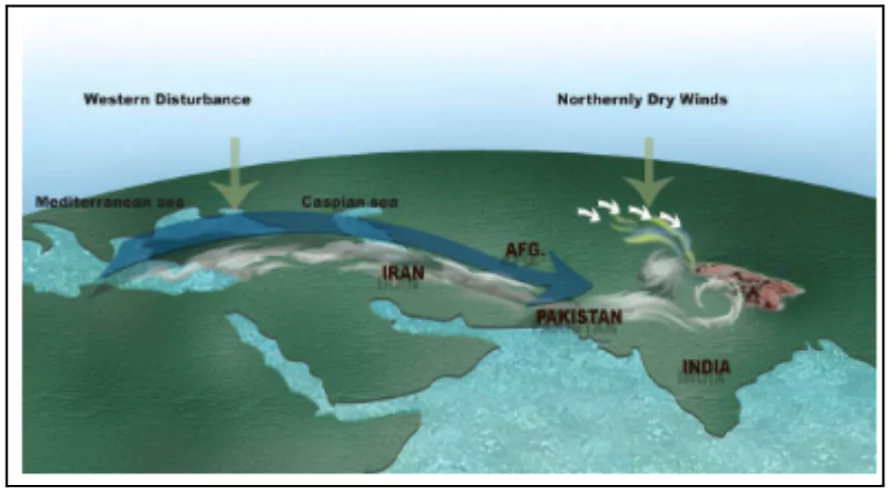Recently Delhi and surrounding areas experienced heavy rainfall and strong winds caused by a Western Disturbance, disrupting flights and causing waterlogging.
- Experts attribute the increasing frequency and intensity of such disturbances to climate change and global warming.
- States like Himachal Pradesh, Uttarakhand, and Jammu & Kashmir faced flash floods and landslides due to intense Western Disturbances in March and April 2025.
What Are Western Disturbances?

- Western Disturbances are extra-tropical low-pressure systems originating near the Mediterranean region.
- They move eastward, carried by the subtropical westerly jet stream towards the Indian subcontinent.
- These disturbances bring rainfall in plains and snowfall in the Himalayan region, particularly during winter (December to February).
- Unlike monsoon systems, they carry moisture in the upper layers of the atmosphere.
- They are crucial for winter rainfall and snowfall over northwest India and the western Himalayas.
Impact of Western Disturbances
- Climate and Weather Influence: Western Disturbances bring essential winter rainfall to northwestern India, causing temperature drops, cold waves, and widespread fog, while also occasionally triggering extreme weather beyond winter.
- Agricultural Significance: These systems support rabi crop (such as wheat ) growth by providing winter precipitation and preserving soil moisture, but excessive or unseasonal rains can harm crops and delay sowing.
- Hailstorm and Crop Damage: Strong Western Disturbances may lead to hailstorms, which can severely damage orchards and vegetable crops across affected regions.
- Glacial and River System Support: Snowfall from Western Disturbances nourishes Himalayan glaciers, maintaining steady flows in rivers like the Ganga and Indus during dry periods.
- Impact on Water Resources: Rainfall and snowmelt from these systems replenish groundwater, fill reservoirs, and support irrigation, though intense events can lead to floods and landslides.
Changing Pattern of Western Disturbances
- Traditionally limited to winter, Western Disturbances now occur more frequently in non-winter months like May, June, and July.
- Their influence has expanded beyond the western Himalayas to include central and eastern parts of the range.
- In recent decades, they have caused extreme rainfall, floods, and landslides during spring and early summer.
- Their presence in pre-monsoon periods can disrupt monsoon onset and agricultural calendars.
- They are now more intense, widespread, and erratic in behavior compared to earlier decades.
Factors Responsible for Changing Pattern
- Rising Temperatures and Stronger Disturbances: Global warming has intensified the subtropical westerly jet stream, making Western Disturbances stronger and more frequent due to enhanced air mass interactions.
- Arabian Sea Warming: Sea surface temperatures in the Arabian Sea have increased by 1.2–1.4°C, adding more moisture to Western Disturbances and increasing their year-round intensity.
- Enhanced Jet Stream Activity: A stronger and warmer upper atmosphere has broadened the jet stream, allowing Western Disturbances to travel farther and stay active longer.
- Shifting Disturbance Paths: Western Disturbances now show more north-south movement, deviating from traditional paths due to increased meridional jet stream oscillations.
- Delayed Jet Stream Retreat: A slower retreat of the subtropical jet delays the monsoon, causing Western Disturbances to overlap with monsoon systems and raising the risk of extreme weather.
- Moisture Availability: Continuous moisture feeding from the Mediterranean, Caspian Sea, and increasingly, the Arabian Sea, sustains disturbances even outside the winter.
- This leads to more off-season rainfall and increases unpredictability in weather patterns.
Conclusion
- The changing pattern and increasing frequency of Western Disturbances are clear indicators of climate change impacts on regional weather systems.
- While they remain vital for winter rainfall and agriculture in northwest India, their intensification and irregularity pose new challenges.
- Understanding and adapting to these evolving patterns is crucial for climate resilience, disaster preparedness, and sustainable agriculture in the region.
Western Disturbances Vs Monsoon
| Aspect |
Western Disturbances |
Monsoon (Southwest) |
| Introduction |
Western Disturbances are extra-tropical weather systems bringing winter rain and snow to northwestern India. |
The monsoon is a seasonal tropical wind system bringing widespread rainfall to most parts of India during summer. |
| Origin |
They originate near the Mediterranean Sea and move eastward. |
They originate due to differential heating of land and sea, primarily influenced by the Indian Ocean. |
| Type of System |
They are low-pressure systems formed in the mid-latitudes. |
They are tropical systems driven by thermal pressure differences and ocean-atmosphere interactions. |
| Season/Months |
Predominantly active during winter (December to February), but increasingly seen in pre-monsoon months. |
Active mainly from June to September during the southwest monsoon season.
Retreating Monsoon Season during October and November which causes rain in the eastern part of the Peninsula. |
| Moisture Source |
They draw moisture from the Mediterranean, Caspian Sea, and Arabian Sea. |
They collect moisture while crossing the warm Indian Ocean and the Bay of Bengal. |
| Main Impact Area |
Affect northwest India and the western Himalayas. |
Impact almost all of India, especially central, western, and northeastern regions. |
| Associated Phenomena |
Cause snowfall, winter rain, fog, and cold waves. |
Bring widespread rain, floods, soil erosion, and break periods. |
| Influencing Factors |
Influenced by the subtropical westerly jet stream. |
Influenced by Inter Tropical Convergence Zone (ITCZ), sea surface temperature, Tibetan heating, and jet streams. |
![]() 5 May 2025
5 May 2025


